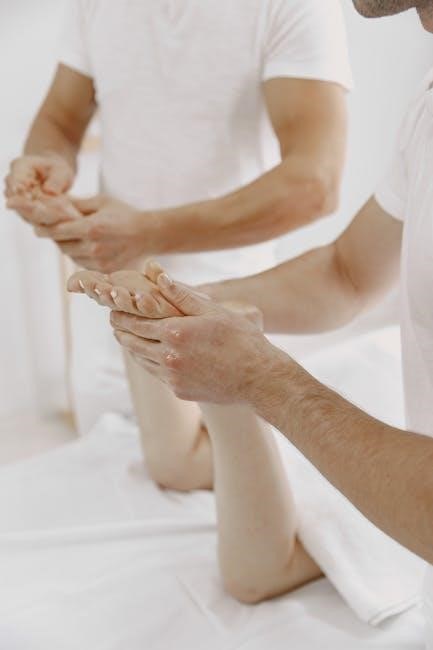The AirCurve ST-A Clinical Manual provides essential guidance for healthcare professionals‚ detailing the safe and effective use of the AirCurve ST-A device for respiratory therapy․
Overview of the AirCurve ST-A Device
The AirCurve ST-A is a bilevel positive airway pressure (BiPAP) device designed for non-invasive ventilation․ It is intended for patients weighing over 30 kg with obstructive sleep apnea (OSA) or respiratory insufficiency․ The device offers adjustable inspiratory and expiratory pressures‚ supplemental oxygen compatibility‚ and multiple operating modes․ Its portability and ease of use make it suitable for both home and hospital settings‚ providing effective therapy for respiratory conditions while ensuring patient comfort and safety․
Importance of the Clinical Manual for Healthcare Providers
The AirCurve ST-A Clinical Manual is a vital resource for healthcare providers‚ offering detailed guidance on device setup‚ operation‚ and troubleshooting․ It ensures safe and effective use of the AirCurve ST-A for patients with respiratory conditions․ The manual provides essential information on therapy modes‚ pressure adjustments‚ and compatibility with accessories․ By following the manual‚ clinicians can optimize patient outcomes‚ ensuring proper device functionality and adherence to clinical protocols․ It serves as a comprehensive guide for mastering the device’s features and settings;
Product Overview and Technical Specifications
The AirCurve ST-A is a bilevel positive airway pressure device designed for patients weighing over 30 kg․ It supports up to 15 L/min of supplemental oxygen‚ featuring biphasic technology for respiratory support in both home and clinical settings․
Key Features of the AirCurve ST-A
The AirCurve ST-A is a bilevel positive airway pressure device offering three therapy modes: S (spontaneous)‚ ST (spontaneous/timed)‚ and VAuto (variable auto-adjusting)․ It provides adjustable inspiratory and expiratory pressures‚ supplemental oxygen compatibility up to 15 L/min‚ and a built-in humidifier for patient comfort․ The device is lightweight‚ portable‚ and designed for both home and hospital settings‚ making it versatile for various patient needs; Its user-friendly interface and advanced features ensure effective respiratory support․
Device Compatibility and Accessories
The AirCurve ST-A is compatible with a range of accessories‚ including humidifiers‚ tubing‚ and masks‚ to enhance patient comfort and therapy effectiveness․ It supports supplemental oxygen up to 15 L/min in all modes‚ ensuring versatility for varying patient needs․ The device is designed to integrate seamlessly with ResMed’s ecosystem‚ offering compatibility with additional components for tailored therapy solutions․ Accessories are available to optimize performance and adapt to different clinical settings․

Indications for Use
The AirCurve ST-A is indicated for the treatment of obstructive sleep apnea and respiratory insufficiency in patients weighing over 30 kg‚ providing non-invasive ventilation support․
Approved Conditions for AirCurve ST-A Use
The AirCurve ST-A is approved for treating obstructive sleep apnea (OSA) and respiratory insufficiency in patients weighing over 30 kg․ It is designed for both home and hospital environments‚ providing non-invasive ventilation support․ The device is also compatible with up to 15 L/min of supplemental oxygen in all modes‚ enhancing versatility for patients with varying needs․ Its bilevel positive airway pressure functionality ensures effective therapy for approved conditions‚ making it a reliable choice for respiratory care․
Patient Weight Requirements
The AirCurve ST-A is intended for patients weighing more than 30 kg (66 lb)․ This requirement ensures safe and effective use of the device for treating obstructive sleep apnea (OSA) and respiratory insufficiency․ The weight guideline applies to both home and clinical settings‚ optimizing therapy outcomes․ Adherence to this requirement is critical for proper device functionality and patient safety‚ as specified in the clinical manual;

Setup and Initialization
The AirCurve ST-A requires careful assembly‚ connection of components‚ and initialization․ Proper setup ensures the device operates effectively for respiratory therapy‚ as outlined in the manual․
Assembly and Preparation of the Device
Assembly begins with unpacking and inspecting all components․ Connect the humidifier and tubing to the main unit‚ ensuring compatibility․ Attach the patient interface‚ such as a mask‚ securely․ If supplemental oxygen is prescribed‚ connect it according to guidelines․ Ensure all connections are tight to prevent leaks․ Power on the device and set the mode (S‚ ST‚ or VAuto) as prescribed․ Adjust inspiratory and expiratory pressures based on clinical requirements․ Prepare accessories like filters and ensure proper operation before patient use․
Connecting the Device to the Patient
Connect the patient interface‚ such as a nasal or full-face mask‚ to the tubing․ Ensure a proper seal to prevent air leaks․ Secure the mask with headgear‚ adjusting straps for comfort․ Connect the tubing to the device’s port․ If using supplemental oxygen‚ attach it to the designated connector․ Turn on the device and allow the patient to acclimate to the airflow․ Monitor for proper operation and adjust settings as needed to ensure effective therapy delivery․
Clinical Benefits and Therapy Modes
The AirCurve ST-A offers advanced therapy modes‚ including S‚ ST‚ and VAuto‚ providing tailored support for obstructive sleep apnea and respiratory insufficiency with adaptive pressure delivery․
Treatment of Obstructive Sleep Apnea (OSA)
The AirCurve ST-A is specifically designed to treat obstructive sleep apnea (OSA) in patients weighing over 66 lb (30 kg)․ It delivers bilevel positive airway pressure‚ ensuring consistent airway patency during sleep․ The device’s S‚ ST‚ and VAuto modes adapt to patient needs‚ providing inspiratory and expiratory pressure support․ This therapy improves sleep quality‚ reduces apnea events‚ and enhances overall respiratory stability‚ making it a highly effective solution for managing OSA․
Non-Invasive Ventilation for Respiratory Insufficiency
The AirCurve ST-A provides non-invasive ventilation for patients with respiratory insufficiency‚ supporting those requiring consistent pressure assistance․ It is suitable for chronic respiratory failure‚ such as in COPD‚ and offers adjustable inspiratory and expiratory pressures; The device is compatible with supplemental oxygen up to 15 L/min‚ enhancing therapy effectiveness․ Its portability and ease of use make it ideal for both home and hospital settings‚ ensuring comprehensive respiratory support for patients with diverse clinical needs․
Operating Modes and Settings
The AirCurve ST-A operates in S‚ ST‚ and VAuto modes‚ providing tailored pressure support for various respiratory needs․ Adjustable inspiratory and expiratory pressures ensure personalized therapy settings․
Explanation of S‚ ST‚ and VAuto Modes
The AirCurve ST-A offers three distinct modes: S (Spontaneous)‚ ST (Spontaneous/Timed)‚ and VAuto (Volume-Assured Pressure Support)․ The S mode delivers pressure only during spontaneous breaths‚ while ST mode adds a backup breath rate for patients needing more support․ VAuto mode automatically adjusts pressures to ensure a stable tidal volume‚ providing adaptive therapy for varying respiratory needs․ Each mode is designed to address specific patient requirements‚ offering flexibility and personalized treatment options․
Adjusting Inspiratory and Expiratory Pressures
Adjusting inspiratory (IPAP) and expiratory (EPAP) pressures on the AirCurve ST-A requires careful consideration of the patient’s condition and therapy mode․ In S mode‚ pressures are set based on spontaneous breaths‚ while ST mode includes a backup breath rate․ VAuto mode automatically adjusts pressures to maintain a stable tidal volume․ Clinicians should use the device’s interface to set IPAP and EPAP‚ ensuring comfort and effectiveness․ Monitoring patient response and adhering to clinical guidelines is essential for optimal therapy adjustments․
Safety Guidelines and Precautions
The AirCurve ST-A requires adherence to safety guidelines to prevent misuse․ Proper usage‚ regular monitoring‚ and following maintenance protocols are essential for patient safety and device functionality․
Contraindications and Warnings
The AirCurve ST-A is contraindicated for patients under 30 kg or with severe respiratory failure requiring invasive ventilation․ Use with caution in patients with chronic respiratory conditions or those requiring high-pressure therapy․ Improper use or failure to follow guidelines may lead to adverse effects․ Ensure proper training and medical supervision for all patients․ Regular monitoring is essential to prevent complications and ensure therapeutic effectiveness․
Supplemental Oxygen Compatibility
The AirCurve ST-A is compatible with up to 15 L/min of supplemental oxygen in all modes‚ enhancing therapy for patients requiring additional oxygen support․ Ensure proper setup and monitoring when using oxygen therapy to maintain safety and effectiveness․ Always follow the clinical manual’s guidelines for oxygen integration to optimize patient outcomes and prevent complications․

Cleaning and Maintenance
Regular cleaning and maintenance of the AirCurve ST-A are crucial for optimal performance and patient safety; Follow the clinical manual’s guidelines for disinfection and part replacement․
Recommended Cleaning Schedule
Regular cleaning of the AirCurve ST-A is essential for maintaining hygiene and functionality․ The clinical manual recommends cleaning the mask‚ tubing‚ and humidifier daily with mild soap and warm water․ The filter should be replaced every 1-2 weeks‚ and the water tank cleaned monthly․ Always rinse thoroughly and allow components to air dry․ Adhere to these guidelines to ensure optimal performance and patient safety․
Replacing Disposable Components
Disposable components of the AirCurve ST-A‚ such as filters and bacterial/viral filters‚ should be replaced regularly to maintain device performance and hygiene․ Standard filters should be replaced every 1-2 weeks‚ while bacterial/viral filters should be replaced every 30 days or as needed․ Ensure all replacements are done with authentic ResMed parts to guarantee safety and compliance with clinical standards․ Always refer to the clinical manual for specific guidance on replacement procedures․

Troubleshooting Common Issues
Common issues with the AirCurve ST-A include alarms‚ pressure fluctuations‚ or connectivity problems․ Always check connections‚ filters‚ and settings․ Refer to the manual for detailed solutions․
Alarms and Error Messages
The AirCurve ST-A device features alarms and error messages to alert clinicians and patients of specific issues․ These include high-priority alarms for apneas‚ low minute ventilation‚ or device malfunctions․ Error messages such as “High Leak” or “Low Pressure” indicate issues with mask fit or system integrity․ Refer to the clinical manual for a comprehensive list of alarms and step-by-step troubleshooting guidance to ensure patient safety and effective therapy delivery․
Resolving Connectivity or Pressure Issues
Connectivity issues may arise due to faulty cables or improper device setup․ Ensure all connections are secure and restart the device if necessary․ Pressure discrepancies‚ such as low or high pressure‚ can be resolved by adjusting the inspiratory and expiratory settings according to patient needs․ Always refer to the clinical manual for detailed troubleshooting steps to maintain optimal therapy and patient comfort․ Regular checks and maintenance can prevent such issues from occurring․
Accessing Clinical Resources
Clinicians can access clinical papers‚ product details‚ webinars‚ and downloadable PDFs by logging into their ResMed account‚ providing comprehensive support for effective patient care and device management․
Downloading the AirCurve ST-A Clinical Guide
The AirCurve ST-A Clinical Guide is available for download on ResMed’s official website․ Clinicians can access it by logging into their account‚ ensuring secure and authorized access․ The guide provides detailed instructions for setup‚ therapy modes‚ and troubleshooting‚ serving as a comprehensive resource for effective device management․ Additionally‚ the PDF format allows for easy printing or digital reference‚ making it a convenient tool for healthcare professionals to optimize patient care with the AirCurve ST-A device․
ResMed Support and Training Materials
ResMed provides comprehensive support and training materials for the AirCurve ST-A‚ including webinars‚ clinical papers‚ and detailed product guides․ These resources are accessible via ResMed’s official website‚ offering clinicians in-depth insights into device operation‚ therapy modes‚ and troubleshooting․ The materials are designed to enhance proficiency in using the AirCurve ST-A‚ ensuring optimal patient care and adherence to clinical best practices․ Regular updates and training programs further support ongoing education for healthcare professionals․
The AirCurve ST-A Clinical Manual offers a comprehensive guide for effective device use‚ ensuring optimal respiratory care and improved patient outcomes through proper setup and adherence to guidelines․
The AirCurve ST-A Clinical Manual is a comprehensive guide designed to ensure healthcare providers can effectively use the device for treating respiratory conditions like OSA and respiratory insufficiency․ It covers setup‚ therapy modes‚ troubleshooting‚ and maintenance‚ providing clear instructions to optimize patient care․ The manual emphasizes safety‚ compatibility with supplemental oxygen‚ and patient weight requirements‚ ensuring clinicians can deliver tailored therapy for improved outcomes․ Adherence to its guidelines is crucial for effective device operation and patient well-being․
Final Recommendations for Clinicians
Clinicians should thoroughly review the AirCurve ST-A Clinical Manual to ensure proper device setup and operation․ Regular patient assessments are crucial to tailor therapy modes and pressures effectively․ Ensure compliance with weight requirements and contraindications․ Always verify supplemental oxygen compatibility and follow safety guidelines․ Maintain device hygiene and replace components as recommended․ Utilizing ResMed’s clinical resources and training materials can enhance proficiency‚ ensuring optimal patient outcomes and adherence to best practices in respiratory care․